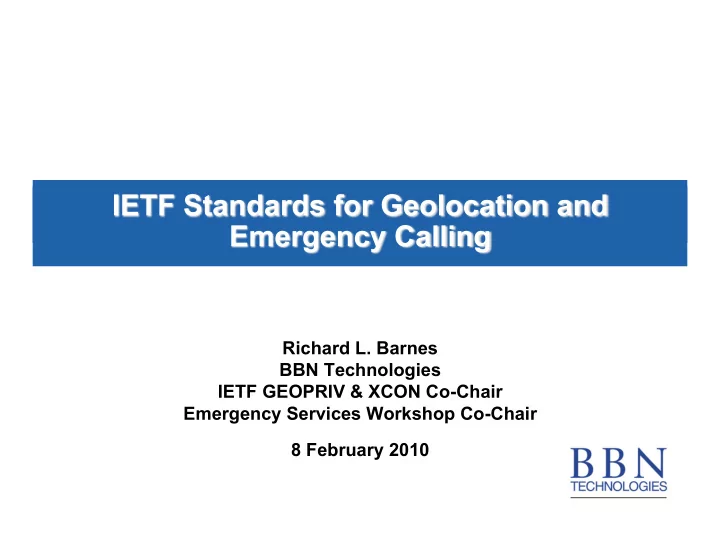

Richard L. Barnes BBN Technologies IETF GEOPRIV & XCON Co-Chair Emergency Services Workshop Co-Chair 8 February 2010
Opinions expressed here are those of the presenter, and do not necessarily represent the consensus views of the IETF, the GEOPRIV or ECRIT WGs, or any other body.
Agenda Location supply and demand Current and emerging location-based applications Current and emerging sources of location information The quest for a Grand Unified Theory
Demand, part 1: Commercial Applications Since time immemorial: Web site localization Relatively coarse precision requirements Incorrect geolocation has low impact Mobile applications have started from the opposite direction High-precision location available (GPS / cellular / wifi) Applications critically depend on highly precise location Demand for highly-precise, highly-accurate location is increasing Mobile applications moving to the desktop Location-based advertising and market analysis
Demand, part 2: VoIP Emergency Calling Calling for help is a critical function of the telephone network, so as more voice is over IP, there’s a desire to replicate that function Critical requirement is context resolution Where is the caller? What are the appropriate emergency resources for that location? The ECRIT architecture thus enables emergency calls by having the caller do two additional steps: Figure out where it is Request contact information for the responsible Public Safety Answering Point (PSAP)
Geolocation in the ECRIT Architecture Location Location Provider Provider 1. Request Location 4. Update Location Caller PSAP 3. Send Location in Call Signaling 2. Request Contact Info using Location Contact Info DB
Geolocation in the ECRIT Architecture Location is needed for two purposes: Routing calls to the correct PSAP Dispatching emergency responders to the location of the emergency Architecture doesn’t specify how location is determined, just standard interface for client General idea that location information is provided by the local IP network to which a caller is connected Physical connection to caller facilitates geolocation Bootstrap off of DHCP to discover local location server
ECRIT Deployment Status Main driver for deployment of location resources required by ECRIT appears to be national regulation as opposed to commercial interests National architectures are starting to mature, based on ECRIT US: NENA i2 / i3 architectures Canada: “Canadian i2” architecture UK: NICC architecture Expect regulations to emerge late this year, with compliance deadlines in 2011 Ongoing Emergency Services Workshop series attempting to facilitate global interoperability
Demand: Summary Commercial and emerging regulatory forces driving interest in location information about Internet hosts Commercial applications are increasingly driving market demand for high-quality geolocation User-facing applications: Mapping, social networking, augmented reality, etc. Infrastructural applications: Advertising, market analysis, network coverage analysis Regulatory frameworks for enabling VoIP emergency calling will require geolocation at two levels Provided to user for call routing Provided to PSAP for emergency response
Supply: Geolocation Techniques Autonomous: GNSS Network-Assisted: Wireless: Trilateration from endpoint-provided measurements Wireline: Wiremap with endpoint-provided connectivity info Network-based: Wireless: Trilateration based on network measurements Wireline: Wiremap with SNMP / DHCP info Third-party: Topology estimation A-GPS
Supply: An Attempt at Taxonomy Authoritative Positioning mechanisms vary along several GNSS A-GNSS ISP Wiremap Enterprise dimensions Cellular E9-1-1 Source of information Global Local Scope of coverage Skyhook / Google Entities involved Latency-based These factors impact the usability of the positioning Observed mechanism in question Precision Target Accuracy Timeliness Protocol requirements Network 3 rd Party
Interoperability General Internet engineering principles have special importance due to the inherent limitations of geolocation services Dynamic discovery: Applications should be able to find the best location service for the circumstances Interoperability: Applications need to be able to talk to multiple different location services Starting to see some movement toward common platforms for Internet geolocation and location-based applications W3C Geolocation WG: Javascript API for web location IETF GEOPRIV WG Internet geolocation protocols in general Privacy protections for geolocation
W3C Geolocation Working Group Javascript API that allows web pages to request geolocation navigator.geolocation.getCurrentPosition(…); How the browser gets location information is unspecified Firefox uses the Google Gears service (wifi) Safari Mobile uses CoreLocation (wifi + GPS) Web apps are beginning to take advantage of the API Google maps, Flickr mobile, et al. Javascript Browser Location Provider
IETF GEOPRIV Working Group GEOPRIV produces protocols and data formats to support geolocation and privacy Interoperable data formats Location Object (PIDF-LO) Privacy Rules Protocols for “location configuration” Internet-general goal to support many positioning systems Generalization to third-party requests for location
Location Objects <presence Geodetic location information entity="pres:sample@example.com"> <tuple id="0851"> Geospatial Markup Language <status> <gp:geopriv> Simplified GML profile <gp:location-info> <gs:Circle> <gml:pos>48.14 16.94</gml:pos> Civic location information <gs:radius>250</gs:radius> </gs:Circle> XML type/value pairs <ca:civicAddress> <ca:country>AT</ca:country> <ca:A1>Wien</ca:A1> Basic privacy rules </ca:civicAddress> </gp:location-info> How long the object can be <gp:usage-rules> retained <gp:retransmission-allowed> yes </gp:retransmission-allowed> Whether the recipient can <gp:retention-expiry> retransmit the object 2010-02-07T21:02:00Z </gp:retention-expiry> Reference to additional rules </gp:usage-rules> </gp:geopriv> </status> <timestamp> 2008-08-19T19:42:55Z </timestamp> </tuple> </presence>
Privacy Rules Presence systems and geolocation systems both require rules for managing access to information, so GEOPRIV worked with the SIMPLE WG to develop a rules syntax “Common-policy”: General framework for access control permissions Conditions: Who can have access to the controlled information Transformations: What version of the information they should get “Geopriv-policy”: Geolocation-specific privacy features [draft-ietf- geopriv-policy] Conditions: Grant access based on location Transformations: Control granularity of location
Location Configuration Protocols “Location configuration” is the process by which a host learns its location from an Internet location provider DHCP options allow configuration alongside network parameters Geodetic information in an ad-hoc binary format Civic information in a binary type/value format (same as PIDF-LO) Location URIs HELD is an XML/HTTP protocol that support more advanced scenarios
Basic HELD (with Discovery) Endpoint gets local access domain name from DHCP Endpoint queries DNS for NAPTR service “LIS:HELD” Endpoint sends HTTP POST request to URI from NAPTR Server returns PIDF-LO and/or location URI access-net.example.org IN NAPTR 100 10 "u" "LIS:HELD" ( ; service "!*.!https://lis.example.org:4802/?c=ex!" ; regex . ; replacement ) POST /?c=ex HTTP/1.1 HTTP/1.1 200 OK Host: lis.example.org:4802 Content-Type: application/held+xml Content-Type: application/held+xml <locationResponse> <locationRequest> <!-- PIDF-LO document --> <locationType exact=“true”> <locationUriSet expires="2006-01-01T13:00:00.0Z”> geo locationURI <locationURI> </locationType> http://lis.example.org:4802/?d=12345 </locationRequest> </locationURI> </locationUriSet> </locationResponse>
Recommend
More recommend